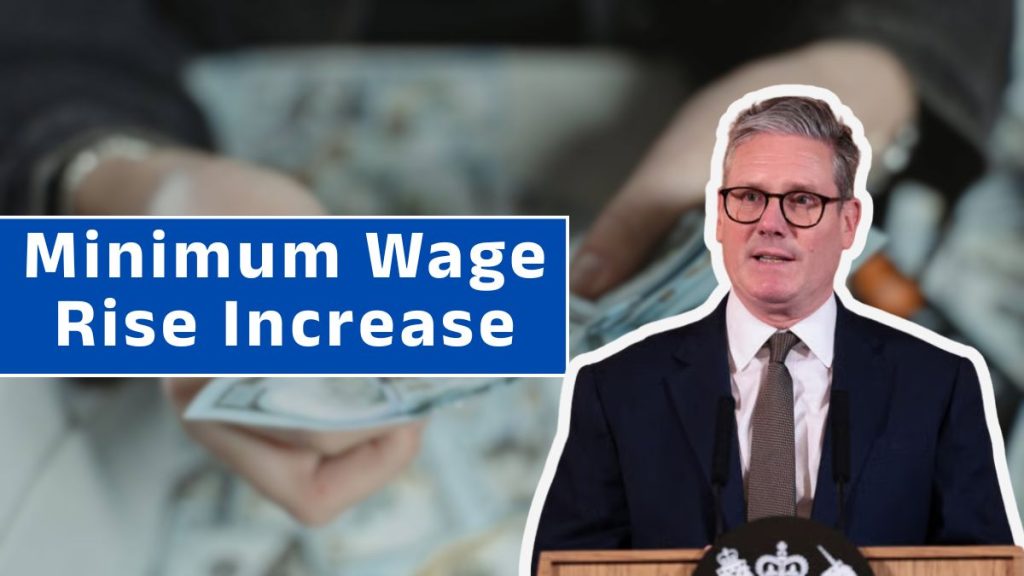From April 2026, the UK government will introduce a new rise in the National Minimum Wage and National Living Wage, marking one of the most significant adjustments in recent years. This increase will affect millions of workers, especially those in lower-income brackets, as well as businesses that will need to adapt to higher staffing costs.
Government Confirms Major Wage Increase

The UK government’s decision to raise the National Minimum Wage (NMW) and National Living Wage (NLW) in April 2026 represents one of the largest pay uplifts in over a decade. The new rates aim to reduce in-work poverty and support households facing ongoing inflation and high living costs.
For millions of low-paid workers, this change translates into extra income each month, while for employers, it introduces new payroll challenges.
Why the Minimum Wage Matters
The National Minimum Wage sets the legal minimum hourly pay for nearly all workers in the UK. The National Living Wage, meanwhile, applies specifically to those aged 23 and above, ensuring that adult workers receive a higher minimum rate.
These wage standards form the foundation of the UK’s fair pay system, designed to:
- Protect employees from exploitation.
- Promote equality in the workplace.
- Support basic living standards across industries.
The Low Pay Commission (LPC) reviews wage rates annually, adjusting them in line with inflation, cost of living, and labour market trends.
Why the Minimum Wage Is Rising in 2026
The April 2026 increase is part of the government’s long-term commitment to improving living standards and reducing income inequality. Several factors contributed to this decision:
- Rising inflation: Households continue to face high prices for essentials like food, rent, and utilities.
- Wage fairness: The government aims to ensure that full-time workers can cover basic living expenses.
- Labour shortages: Key sectors such as hospitality, retail, and social care are struggling to attract and retain workers.
- Economic growth goals: Increasing wages boosts spending power, stimulating the wider economy.
Overall, the increase is a strategic move to balance worker welfare with economic sustainability, helping millions of employees maintain financial security.
New Minimum Wage and Living Wage Rates (From April 2026)
The government has confirmed the new rates that will come into effect on 1 April 2026:
| Category | New Rate (per hour) | Previous Rate (per hour) |
|---|---|---|
| National Living Wage (23 and over) | £12.50 | £11.44 |
| 21–22 year olds | £11.40 | £10.18 |
| 18–20 year olds | £9.10 | £8.60 |
| 16–17 year olds | £7.25 | £6.40 |
| Apprentices | £6.50 | £5.90 |
This rise is particularly significant for younger workers, who will see the largest proportional pay jump in several years.
Who Will Benefit the Most
The wage increase will positively impact a range of sectors and workers across the UK, including:
- Retail employees: Many earn close to the minimum wage and will now see meaningful increases.
- Hospitality workers: Bar staff, kitchen assistants, and waiting teams will benefit from higher hourly pay.
- Social care and healthcare workers: Carers and support workers will see boosts that better reflect their essential roles.
- Young workers: Those under 23 will notice a major uplift in their income compared to previous years.
- Apprentices: Although paid at a lower rate, apprentices will also receive a welcomed pay boost.
This increase is expected to benefit more than 3 million workers across the UK.
What It Means for Workers
For employees, the 2026 minimum wage rise represents real financial relief. The benefits include:
- Higher take-home pay: Full-time minimum wage earners could earn around £2,000 more annually than before.
- Improved living standards: Better ability to afford essentials such as rent, groceries, and transport.
- Reduced financial stress: Households on tight budgets will find it easier to cope with rising bills.
- Stronger motivation: Feeling fairly rewarded can boost morale and workplace productivity.
For many, this pay rise is not just an economic adjustment but a step toward fairer work and financial independence.
Impact on Businesses
While the change is good news for workers, it also poses challenges for employers, particularly small businesses. The main effects include:
- Higher payroll costs: Sectors like hospitality and retail, which employ large numbers of minimum wage workers, will face rising wage bills.
- Price adjustments: Some companies may raise prices to offset increased staffing costs.
- Pressure on profits: Businesses already affected by energy and supply chain costs may find it difficult to maintain margins.
- Need for efficiency: Employers might look to automation, productivity improvements, or reduced working hours to manage expenses.
However, businesses could also experience positive outcomes, such as:
- Improved employee retention.
- Lower turnover and recruitment costs.
- Enhanced job satisfaction and productivity.
Government Support for Employers
To ease the transition, the UK government has hinted at potential support measures for small and medium enterprises (SMEs), including:
- Tax reliefs and credits to offset increased payroll costs.
- Training and apprenticeship incentives to upskill the workforce.
- Sector-specific support for industries most impacted by wage changes.
Employers are encouraged to plan ahead, reassess budgets, and consult accountants or payroll experts to manage the change smoothly.
Wider Economic Effects
The minimum wage increase will ripple across the UK economy in several key ways:
- Boosting consumer spending: Workers with higher incomes will have more purchasing power, supporting local businesses.
- Reducing inequality: Higher wages help narrow the gap between the lowest and highest earners.
- Encouraging workforce participation: Improved pay rates may attract more people back into employment.
- Possible inflationary pressure: If wage growth drives up prices, the government will monitor economic stability closely.
Economists note that while the wage rise could slightly raise business costs, it will also strengthen the overall economy through increased spending and productivity.
Preparing for the Change
Both employees and employers are advised to prepare early for the April 2026 adjustments.
- Workers should confirm their hourly rates and ensure they are correctly updated in payslips.
- Employers should review payroll systems, update contracts, and communicate changes to staff.
The HMRC National Minimum Wage helpline and official government website offer tools to verify pay compliance and avoid penalties.
The Bigger Picture: A Fairer Future for Workers
The 2026 wage rise underscores the government’s long-term vision of a “high-wage, high-skill, high-productivity economy.”
By ensuring fairer pay for the lowest earners, the UK aims to build a stronger, more resilient workforce. The adjustment may challenge businesses in the short term, but it is a crucial step toward sustainable economic growth and greater equality in the labour market.
FAQs on UK Minimum Wage Rise April 2026
Q1. When will the new minimum wage rates take effect?
The new National Minimum Wage and National Living Wage rates will apply from 1 April 2026.
Q2. Who qualifies for the National Living Wage?
The National Living Wage applies to all workers aged 23 and above. Those under 23 receive the National Minimum Wage according to their age group.
Q3. How much more will workers earn?
A full-time worker on the new National Living Wage could earn around £2,000 more per year than before.
Q4. Will businesses receive government support?
Yes. The government plans to offer tax incentives and small business reliefs to help employers adjust to the new rates.
Q5. How can I check my pay?
You can verify your hourly pay using the official GOV.UK wage calculator or by checking your payslip and employment contract for updates after April 2026.















